When we say “electric organ”, we tend to think of either the classic ’70s-style organs used by Ray Manzarek of the Doors or the rock-style playing of John Lord from Deep Purple. But electric organs come in a variety of shapes and sizes, and some are based very much on the traditional look of an organ, whilst others are similar to a keyboard.
They’re derived from traditional and reed-based organs. It wasn’t until the late 1900s that organs became electric. These newer models are incredibly versatile and easily utilised for chord and lead work.
Some electric organs even have drawbars, akin to their acoustic counterparts, which control the volume of a particular sound component. If you’re baffled by the array of options out there on the market, don’t fret – we’re here with our list of the best electric organs to help you choose the right one for you!
In a hurry?
Here are our favourite electric organs at a glance and why we love them:
| Viscount Legend Soul 261 Digital Tonewheel Organ | Tone modelling technology offers classic organ tones. | Check the current price |
| Nord Stage 4 Compact Digital Piano | Physical drawbars with LED indicators. | Check the current price |
| Roland VR-730 73-Note Live Performance Keyboard | Authentic organ sounds with extensive editing parameters and an easy-to-use interface. | Check the current price |
The best electric organs
1. Viscount Legend Soul 261 Digital Tonewheel Organ
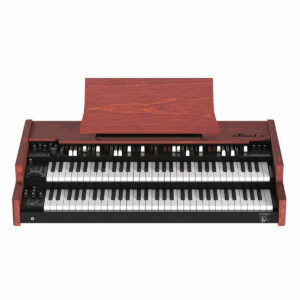 Key features
Key features
- Tone modelling technology offers classic organ tones
- Features a nine-contact mechanism for a traditional playing experience
- Vibrato and chorus effects modelled off classic organs allow for a variety of sounds
- Easy-to-use interface with two sets of drawbars – perfect for players looking for efficiency
Pros
- Ideal for players looking for an electric organ with a traditional look and sound
- Realistic organ tones specifically modelled to replicate an organ
- Incredibly efficient to use thanks to the easy interface
Cons
- Not ideal for beginners, rather, it’s aimed at serious organ enthusiasts and professional players
The Viscount Legend Soul 261 Digital Tonewheel Organ is suited to players who are looking for an electric organ with the same aesthetic and feel as a traditional organ. Not only through looks is the Viscount Legend Soul 261 very similar to a traditional organ, but it has also been modelled to provide a realistic organ tone.
It boasts a patented virtual recreation of a nine-contact mechanism, replicating the workings of a vintage tone wheel organ. In fact, the Viscount Legend has been crafted with great attention to detail and even features the distinctive clicking that one would expect to hear on a traditional organ as each key is played. Plus, the vibrato and chorus effects are modelled off classic organs to give you a realistic sound.
Equipped with two complete manuals, each sporting 61 full-sized, velocity-sensitive, semi-weighted keys, and an expressive drawbar system, crafting your unique sound has never been easier. The Legend Soul 261 is ideal for players who want a quick and easy sound selection, a user-friendly interface, and two sets of drawbars that let you shape your sound seamlessly.
2. Viscount Legend Live Portable Organ
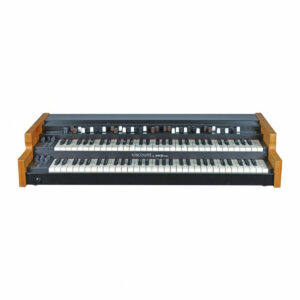 Key Features
Key Features
- Dual manuals with drawbars allow you to easily alter your tone
- Portable body provides the experience of a tonewheel organ with a compact body
- Physical modelling produces flawless vintage tones
- Flexible routing options to suit live and recording situations
Pros
- Features drawbars for a tailored sound
- A good choice for any player looking for an organ to gig with
- Physical modelling technology provides classic vintage tones
Cons
- Not suited to beginner players due to its complexity
The Viscount Legend Live Portable Organ is suited to players looking for a digital organ to gig with whilst still achieving a realistic and quality organ sound. This powerhouse of an instrument boasts dual manuals with four sets of nine drawbars, allowing for endless tonal possibilities.
The authentic tone wheel experience in a portable body provides all the benefits of modern electric organs. But physical modelling takes it to another level, providing faultless vintage organ tones through the use of tonewheel modelling technology.
With flexible routing options to meet all your needs, this organ is perfect for professional musicians and passionate hobbyists alike.
3. Nord Stage 4 Compact Digital Piano
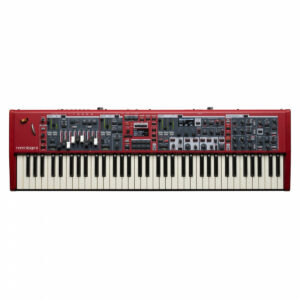 Key Features
Key Features
- 73-note triple sensor keybed with semi-weighted keys
- Three powerful sound engines – revamped and enhanced
- Effects section with expanded variations and controls
- Expanded preset library with Nord’s award-winning instrument simulations
- Physical drawbars with LED indicators
Pros
- Physical drawbars with LED indicators provide a tailored sound and look
- Triple sensor keybed offers an accurate response
- Great for players looking to achieve other sounds and tones as well as organ tones
Cons
- Not suited to beginner players due to its complexity and vast sound options
The Nord Stage 4 Compact Digital Piano is perfect for players looking for a technical digital piano that has the quality sounds of an electric organ. It comes with a 73-note triple sensor keybed with semi-weighted keys, allowing you to play beautiful, expressive melodies.
Three revamped powerful sound engines produce supremely high-quality sound, whilst the effects section with expanded variations and controls allows you to effortlessly customise your music to your preferences.
What’s more, the expanded preset library features Nord’s award-winning instrument simulations, giving you a vast selection of sounds to choose from. Plus, there are physical drawbars with LED indicators that enhance the overall look of the piano, as well as suit any player who wants to tailor their overall sound.
4. Roland VR-09-B V-Combo Keyboard
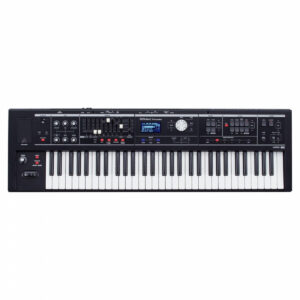 Key Features
Key Features
- Compact, lightweight frame that’s ideal for gigging
- Easy-to-use control panel for quick playing transitions during performances
- Three sound engines for a powerful, authentic tone
- SuperNATURAL technology offers tonewheel organs and nine harmonic bars for a controlled performance
Pros
- Ideal for players looking for a keyboard to gig with
- Control panel provides seamless transitions when playing live
- Extremely comfortable and expressive keyboard
Cons
- Not solely an electric organ, so it’s better suited to players who also want piano and synth sounds
The Roland VR-09-B V-Combo Keyboard is a great choice for anybody wanting a keyboard for live performance that can provide a good standard of electric organ tone. It’s easy to transport and boasts a compact and lightweight frame, making it the perfect choice for musicians who are always on the go.
The easy-to-use control panel ensures that you can quickly and easily dial in your perfect sound without any confusion or frustration. Complete with three onboard sound engines, it delivers an organic tone that is simply unmatched by other keyboards in its class. With 245 sounds, including organs, synths, and pianos, you can explore a wide range of musical styles and genres.
It includes Roland’s cutting-edge SuperNATURAL technology to ensure realistic sounds and samples. This technology powers the virtual tone wheel organ with nine harmonic bars, offering greater control over your sound. Better still, it’s packed with world-class organ sounds from the 1960s.
The Roland VR-09-B-V-Combo also offers fast response – perfectly suited to organ techniques such as trill, sputter, glissando, and percussive hits. And thanks to its expressive response, it’s easy to create music that truly speaks to you. Whether you’re a seasoned pro or a newcomer to the organ, the Roland VR-09-B V-Combo Keyboard will impress you with its exceptional sound quality and user-friendly features.
5. Yamaha YC88 Digital Stage Keyboard with Drawbars
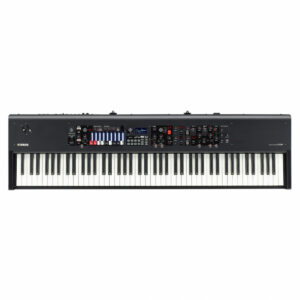 Key Features
Key Features
- Includes drawbars, giving you control over your sound
- Natural wood hammer-action keybed for fluid playability
- Detailed organ, piano, and synthesizer sounds
- Intuitive control surface and sound editing
- Lightweight design built for live performances
Pros
- Provides a wide scope of detailed organ, piano, and synthesizer sounds
- Ideal for live performances due to its lightweight design
- Has drawbars to offer control over your sound
Cons
- Might be a bit too complex for those looking for just organ sounds
The Yamaha YC88 Digital Stage Keyboard with Drawbars is designed for use on stages and perfect for any player looking to incorporate organ, piano, and synth tones into their playing. This impressive instrument boasts a natural wood hammer-action key bed that allows for unparalleled fluidity while playing.
The keyboard also features a wide variety of meticulously crafted sounds, including detailed organ, piano, and synthesizer tones. With its intuitive control surface and sound editing features, the Yamaha YC88 is versatile enough to meet the needs of any musician. And when it’s time to hit the stage, the lightweight design of the keyboard makes it a breeze to transport and set up for live performances.
6. Roland VR-730 73-Note Live Performance Keyboard
 Key Features
Key Features
- Authentic organ sounds with extensive editing parameters
- Waterfall-style keyboard for authentic performance
- Lightweight frame that’s perfect for gigging
- User-friendly interface
- Semi-weighted keyboard
Pros
- Has authentic organ sounds
- Easy-to-use interface to allow for easy tonal shaping
- Ideal for gigging due to its lightweight frame
Cons
- Doesn’t feature as many controls as other models
The Roland VR-730 73-Note Live Performance Keyboard is perfect for live performances and players who are looking to edit their sound in detail with a keyboard that will allow you to play synth, organ, and piano sounds. Featuring 73 notes and packed with authentic organ sounds and extensive editing parameters, this keyboard is incredibly versatile.
The waterfall-style keyboard, which is popular with organs, is perfect for those who crave an authentic performance, and the lightweight frame ensures it won’t become a burden while gigging.
And to top it off, the interface is extremely user-friendly, allowing for easy tonal shaping, so you can customise your sound to suit any genre or style.
A brief history
The electric organ, also referred to as the electronic organ, is a musical instrument that has played an important role in many genres of music over the years. Its origins can be traced back to the early 20th century when inventors began experimenting with electronic devices that could produce sounds similar to those of traditional pipe organs.
Over time, these devices became more sophisticated, and by the 1950s, electric organs had become popular in jazz, rock, and pop music and slowly made their way onto music scenes in the 1960s and 1970s with bands such as Deep Purple and The Doors incorporating organs into a lot of their music. One of the most notable pieces of music played on an electric organ is Stevie Wonder’s “Superstition”.
The instrument’s versatility and unique sound made it a favourite of musicians looking to experiment with new sounds and ways of playing. Today, the electric organ continues to be used by musicians around the world, in many different genres.
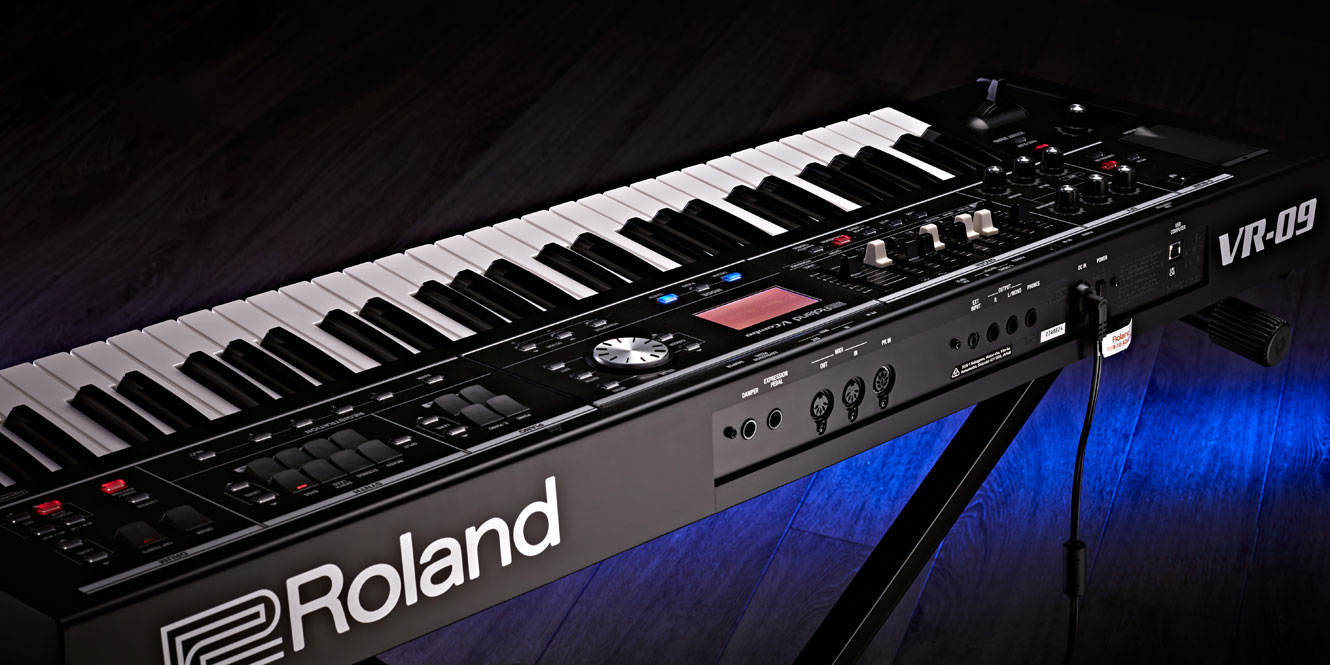
Things to consider when buying an electric organ
Which presets and effects do you need?
It’s a good idea to take into account what you want to get out of your playing, for example, are you looking to incorporate certain effects into your sound? Some organs come complete with percussion effects and vibrato, whilst others have a wide range of presets for you to play with.
If you’re looking for a more piano-based organ, opt for an electric organ with a good choice of piano presets. Some people do prefer to have a varied amount of voices to choose from, more so than what an electric organ can provide. In this instance, workstations are a great way of achieving a varied amount of sounds – especially if you want a piano that also functions as a workstation.
Models such as the Roland Fantom Series synthesizer keyboards offer legendary sounds with everything you need to create and perform your own music.
Check the quality of sampled sounds
The variety and quality of sampled sounds can vary depending on the organ. If you’re looking to use your electric organ simply for practising, you may not be bothered about paying more for high-quality sounds. However, if you want to gig and record with your electric organ, realistic-sounding samples would be beneficial, so you should choose an organ to reflect this.
The polyphony of the electric organ is another aspect to be aware of. This will determine how full the overall sound is, essentially representing how many notes can be played at one time.
Do you need a sustain pedal?
Although it’s not always needed, a sustain pedal could be extremely beneficial to your sound. A sustain pedal delivers more body to your sound, ensuring it doesn’t feel thin. Whilst most electric organs do include a sustain pedal, it’s always best to check before you buy.
Naturally, an organ is renowned for its many pedals and so electric organs sometimes come with additional pedals such as vibrato, chorus, and reverb.
What is the lifespan of an electric organ?
The life span of an electric organ vastly depends on the quality and the age of the instrument, although they do last for a decent amount of time! Like with any electrical equipment, it depends on how well you look after and maintain the organ.
An average lifespan for a new electric organ is approximately 20 years, although this may depend on the electronic components and how well they age over time. This is something to be aware of if you’re buying an electric organ second hand, knowing how old it is will give you a clear indication of how many years of use you can get out of it.
What are the benefits of an electronic orchestral instrument?
Electric orchestral instruments can be incredibly beneficial, especially for musicians who want to choose the volume they play at or practise silently. Instruments such as electric organs and electric violins can be plugged into an amplifier for a more powerful output, listened back to via headphones, or even used as MIDI controller depending on its outputs.
Another benefit of electronic orchestral instruments is that they don’t need to be maintained as much as acoustic instruments because the natural sound is not resonating from the instrument itself. However, a certain degree of maintenance is still required.
In terms of efficiency, most electric orchestral instruments are much smaller and more portable than their acoustic counterparts. A prime example of this is a full-sized traditional organ compared to a compact electric organ.
They also tend to be packed with a wide range of sounds all in one place, allowing you to achieve a vast array of tones.
Even better, electric instruments don’t require tuning, this alone can save you money on big items, such as pianos and organs, that would normally require meticulous and regular tuning.
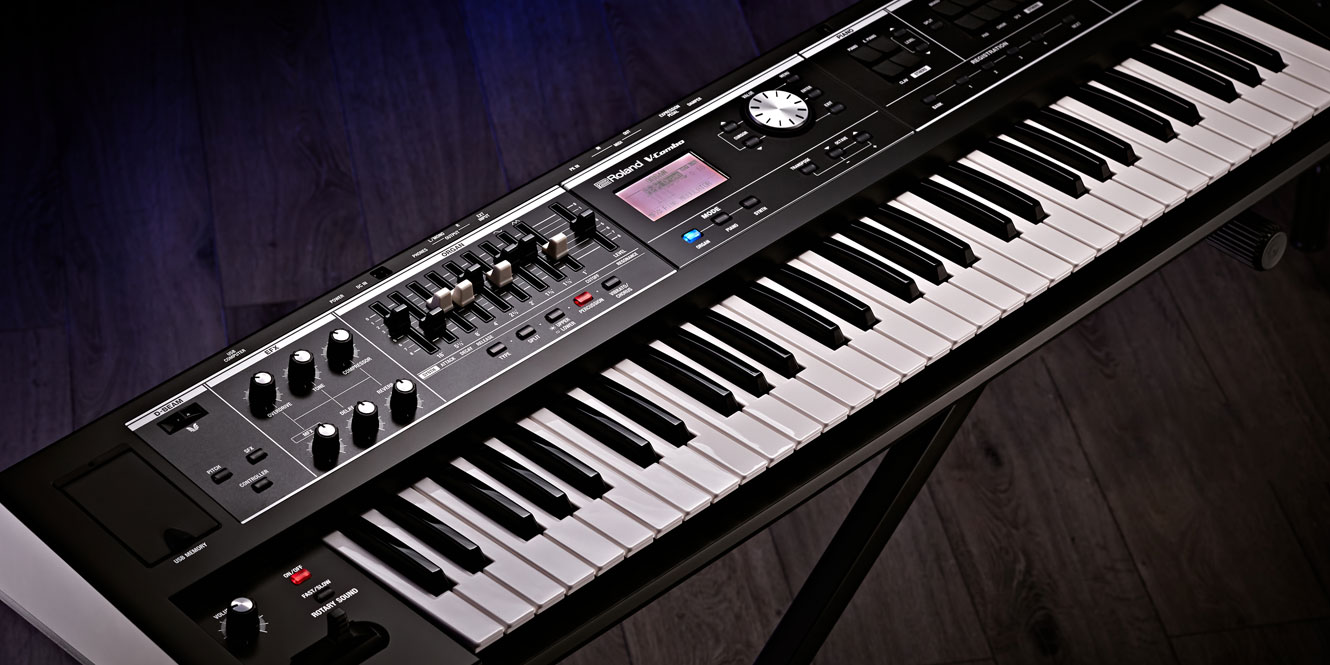
FAQs
What is one of the most famous electric organs?
One of the most famous electric organs is the Hammond Organ. This brand is incredibly popular; it has a rich history of making organs and dates back to 1935.
How long do electric organs last?
Electric organs can last for many years, with most organs expected to last at least 20 years. This, however, depends on how well-maintained the organ is and assumes all its parts remain in good condition.
Why do electric organs have two keyboards?
Many electric organs have two keyboards to allow the player to create various layers, just like you would on an acoustic organ, and quickly switch between different sounds.
Final thoughts
There are a variety of different types of electric organs out there, and each one is a great way to achieve that distinctive organ sound, whilst allowing you to explore some extra features that acoustic organs don’t have. Plus, their smaller, more portable size makes them a great choice for those who are limited in space or want an electric organ to gig with.
We hope our picks of the best electric organs have cleared up some of the jargon out there and helped you choose the right one for you! After more organs? Why not check out our full range?

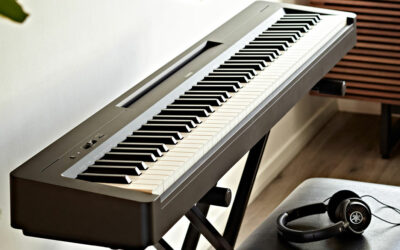

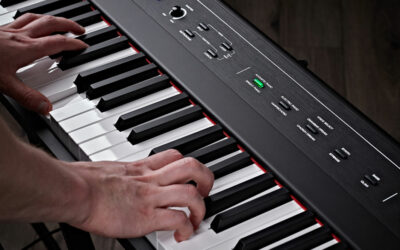

0 Comments